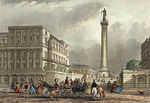Carlton House was a mansion in Westminster, best known as the town residence of King George IV. It faced the south side of Pall Mall, and its gardens abutted St James's Park in the St James's district of London. The location of the house, now replaced by Carlton House Terrace, was a main reason for the creation of John Nash's ceremonial route from St James's to Regent's Park via Regent Street, Portland Place and Park Square: Lower Regent Street and Waterloo Place were originally laid out to form the approach to its front entrance.
An existing house was rebuilt at the beginning of the eighteenth century for Henry Boyle, created Baron Carleton in 1714, who bequeathed it to his nephew, the architect Lord Burlington. Burlington's mother sold it in 1732 to Frederick, Prince of Wales, for whom William Kent laid out the garden. Frederick's widow Augusta, Princess of Wales, enlarged the house; in 1783, when Frederick's grandson George, Prince of Wales, was granted possession of Carlton House and £60,000 to refurbish it, it was a rambling structure without architectural cohesion.The Prince had the house substantially rebuilt by the architect Henry Holland between 1783 and 1796. By the time the Prince Regent and Henry Holland parted company in 1802, Carlton House was a spacious and opulent residence, which would have been designated a palace in many countries. From the 1780s it was the centre of a glittering alternative court to that of the Prince's parents at St James and Buckingham House. After 1811 when he became Prince Regent the house was altered and redecorated to suit an even larger amount of usage as a palace in all but name.
In 1820, on the death of his father, George III, the Prince Regent became King George IV. He deemed that Carlton House, the official royal residence of St. James's Palace and his parents' Buckingham House were all inadequate for his needs. Some consideration was given to rebuilding Carlton House on a far larger scale, but in the end Buckingham House was rebuilt as Buckingham Palace instead. Carlton House was demolished in 1826 and replaced with two grand white stuccoed terraces of expensive houses known as Carlton House Terrace. The proceeds of the leases were put towards the cost of Buckingham Palace.










